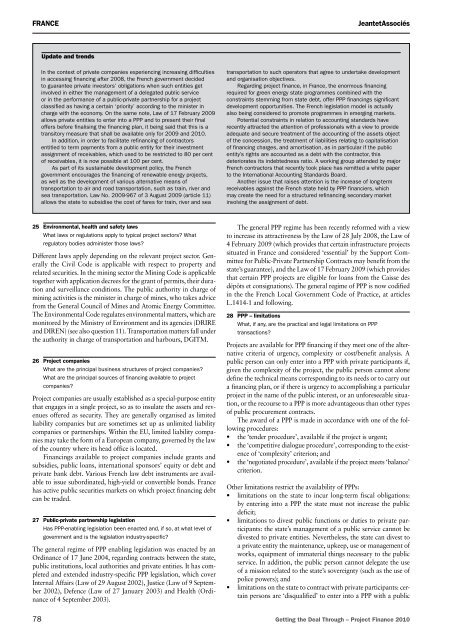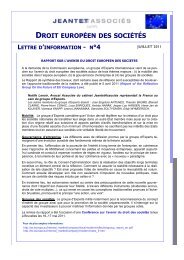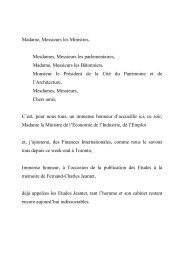Project Finance - Jeantet.fr
Project Finance - Jeantet.fr
Project Finance - Jeantet.fr
You also want an ePaper? Increase the reach of your titles
YUMPU automatically turns print PDFs into web optimized ePapers that Google loves.
<strong>fr</strong>ance<strong>Jeantet</strong>AssociésUpdate and trendsIn the context of private companies experiencing increasing difficultiesin accessing financing after 2008, the French government decidedto guarantee private investors’ obligations when such entities getinvolved in either the management of a delegated public serviceor in the performance of a public-private partnership for a projectclassified as having a certain ‘priority’ according to the minister incharge with the economy. On the same note, Law of 17 February 2009allows private entities to enter into a PPP and to present their finaloffers before finalising the financing plan, it being said that this is atransitory measure that shall be available only for 2009 and 2010.In addition, in order to facilitate refinancing of contractorsentitled to term payments <strong>fr</strong>om a public entity for their investmentassignment of receivables, which used to be restricted to 80 per centof receivables, it is now possible at 100 per cent.As part of its sustainable development policy, the Frenchgovernment encourages the financing of renewable energy projects,as well as the development of various alternative means oftransportation to air and road transportation, such as train, river andsea transportation. Law No. 2009-967 of 3 August 2009 (article 11)allows the state to subsidise the cost of fares for train, river and seatransportation to such operators that agree to undertake developmentand organisation objectives.Regarding project finance, in France, the enormous financingrequired for green energy state programmes combined with theconstraints stemming <strong>fr</strong>om state debt, offer PPP financings significantdevelopment opportunities. The French legislation model is actuallyalso being considered to promote programmes in emerging markets.Potential constraints in relation to accounting standards haverecently attracted the attention of professionals with a view to provideadequate and secure treatment of the accounting of the assets objectof the concession, the treatment of liabilities relating to capitalisationof financing charges, and amortisation, as in particular if the publicentity’s rights are accounted as a debt with the contractor, thisdeteriorates its indebtedness ratio. A working group attended by majorFrench contractors that recently took place has remitted a white paperto the International Accounting Standards Board.Another issue that raises attention is the increase of long-termreceivables against the French state held by PPP financiers, whichmay create the need for a structured refinancing secondary marketinvolving the assignment of debt.25 Environmental, health and safety lawsWhat laws or regulations apply to typical project sectors? Whatregulatory bodies administer those laws?Different laws apply depending on the relevant project sector. Generallythe Civil Code is applicable with respect to property andrelated securities. In the mining sector the Mining Code is applicabletogether with application decrees for the grant of permits, their durationand surveillance conditions. The public authority in charge ofmining activities is the minister in charge of mines, who takes advice<strong>fr</strong>om the General Council of Mines and Atomic Energy Committee.The Environmental Code regulates environmental matters, which aremonitored by the Ministry of Environment and its agencies (DRIREand DIREN) (see also question 11). Transportation matters fall underthe authority in charge of transportation and harbours, DGITM.26 <strong>Project</strong> companiesWhat are the principal business structures of project companies?What are the principal sources of financing available to projectcompanies?<strong>Project</strong> companies are usually established as a special-purpose entitythat engages in a single project, so as to insulate the assets and revenuesoffered as security. They are generally organised as limitedliability companies but are sometimes set up as unlimited liabilitycompanies or partnerships. Within the EU, limited liability companiesmay take the form of a European company, governed by the lawof the country where its head office is located.Financings available to project companies include grants andsubsidies, public loans, international sponsors’ equity or debt andprivate bank debt. Various French law debt instruments are availableto issue subordinated, high-yield or convertible bonds. Francehas active public securities markets on which project financing debtcan be traded.27 Public-private partnership legislationHas PPP-enabling legislation been enacted and, if so, at what level ofgovernment and is the legislation industry-specific?The general regime of PPP enabling legislation was enacted by anOrdinance of 17 June 2004, regarding contracts between the state,public institutions, local authorities and private entities. It has completedand extended industry-specific PPP legislation, which coverInternal Affairs (Law of 29 August 2002), Justice (Law of 9 September2002), Defence (Law of 27 January 2003) and Health (Ordinanceof 4 September 2003).The general PPP regime has been recently reformed with a viewto increase its attractiveness by the Law of 28 July 2008, the Law of4 February 2009 (which provides that certain in<strong>fr</strong>astructure projectssituated in France and considered ‘essential’ by the Support Committeefor Public-Private Partnership Contracts may benefit <strong>fr</strong>om thestate’s guarantee), and the Law of 17 February 2009 (which providesthat certain PPP projects are eligible for loans <strong>fr</strong>om the Caisse desdépôts et consignations). The general regime of PPP is now codifiedin the the French Local Government Code of Practice, at articlesL.1414-1 and following.28 PPP – limitationsWhat, if any, are the practical and legal limitations on PPPtransactions?<strong>Project</strong>s are available for PPP financing if they meet one of the alternativecriteria of urgency, complexity or cost/benefit analysis. Apublic person can only enter into a PPP with private participants if,given the complexity of the project, the public person cannot alonedefine the technical means corresponding to its needs or to carry outa financing plan, or if there is urgency to accomplishing a particularproject in the name of the public interest, or an unforeseeable situation,or the recourse to a PPP is more advantageous than other typesof public procurement contracts.The award of a PPP is made in accordance with one of the followingprocedures:• the ‘tender procedure’, available if the project is urgent;• the ‘competitive dialogue procedure’, corresponding to the existenceof ‘complexity’ criterion; and• the ‘negotiated procedure’, available if the project meets ‘balance’criterion.Other limitations restrict the availability of PPPs:• limitations on the state to incur long-term fiscal obligations:by entering into a PPP the state must not increase the publicdeficit;• limitations to divest public functions or duties to private participants:the state’s management of a public service cannot bedivested to private entities. Nevertheless, the state can divest toa private entity the maintenance, upkeep, use or management ofworks, equipment of immaterial things necessary to the publicservice. In addition, the public person cannot delegate the useof a mission related to the state’s sovereignty (such as the use ofpolice powers); and• limitations on the state to contract with private participants: certainpersons are ‘disqualified’ to enter into a PPP with a public78 Getting the Deal Through – <strong>Project</strong> <strong>Finance</strong> 2010





